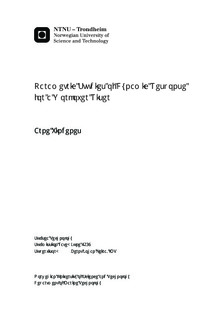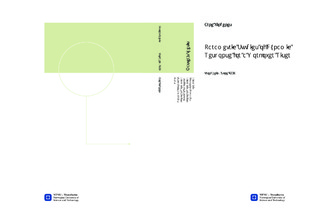| dc.description.abstract | A workover riser is a top tensioned riser, in essence similar to a marine riser. Workover risers differ from marine risers mainly by smaller dimensions, as well as simpler solutions at the riser ends. For instance, the lower flex joint of the marine riser is in the workover riser replaced by a tapered stress joint, and the workover riser has no telescopic joint at the upper end. The similarities between workover and marine risers make it convenient to apply the knowledge acquired for marine risers when performing analyses for workover risers. However, based on the findings in this thesis, one must be careful when assuming similarities between marine and workover risers.
The main purpose of this thesis is to investigate the feasibility of a monitoring system for workover risers. This investigation requires an understanding of a workover riser s behavior, and its response to relevant excitations. A literature review has been done, describing the various workover riser components, as well as the actual applications for a workover riser. The monitoring system suggested will utilize a set of strain sensors. Strain sensors are already mounted on the riser s stress joint and tension joint. A review of strain sensor technology is included.
A workover riser system has been modeled in two separate softwares, Flexcom and RIFLEX. A brief review of selected aspects of these softwares are provided. Two separate softwares were required in order to validate the analysis results, as the riser s dynamic behavior was different from what was expected. The unexpected results occurred as the level of current was changed. It was found that an increased current magnitude is beneficial with respect to the riser s fatigue life. By reducing the current magnitude, from the design condition with one year return period, by a factor of ten, the lifetime of certain riser components has been found to drop by a factor of approximately 16 in one of the softwares. This trend was also validated by the other software, though the factor by which the fatigue life drops remains disputable.
A monitoring system is suggested, where the fatigue damage of each component is extrapolated from the known values at the riser s stress joint. This system requires two extrapolation factors; one factor considers each component s location compared to the stress joint, while the other factor accounts for the environmental conditions. Determining the value of the factor accounting for environmental conditions has proved the biggest challenge. Particularly, the effect of current and current direction must be mapped thoroughly. Measuring the current with sufficient accuracy can prove difficult as well. Riser tension must also be studied further, as it is not only an influential parameter itself, but it also affects other parameters.
Based on the analyses done in this thesis, it is concluded that the feasibility of a riser monitoring system for estimation of fatigue damage is promising. A definite conclusion cannot be drawn, as large amounts of work remain in order to map the influence of all important parameters accurately. It is found that the development of such a monitoring system is an ambitious undertaking, though it appears possible. | |

